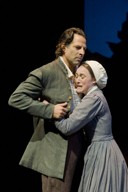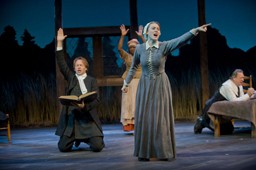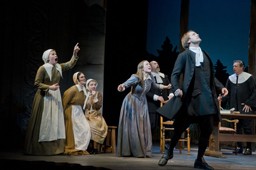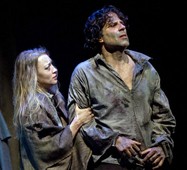Arthur Miller's The Crucible
Barrington Stage Company Brilliantly Initiates a Berkshires Dialogue
By: Charles Giuliano - Oct 12, 2010
The Crucible
By Arthur Miller
Directed by Julianne Boyd
Scenic Designer, David M. Barber; Costume Designer, Kristina Sneshkoff; Lighting Designer, Scott Pinkney; Sound Designer, Brad Berridge.
Cast: Reverend Parris (Peter Samuel), Betty Parris (Caroline Mack), Tituba (Starla Benford), Abigail Williams (Jessica Griffin), Susanna Wolcott (Gabrielle Smachetti), Ann Putnam/Martha Corey (Peggy Pharr Wilson), Thomas Putnam (Jeff Kent), Mercy Lewis, (Maggie Donnelly), Mary Warren (Betsy Hogg), John Proctor (Christopher Innvar), Rebecca Nurse/Sarah Good (Rosalind Cramer), Giles Corey (Gordon Stanley), Reverend John Hale (Fletcher McTaggart), Elizabeth Proctor (Kim Stauffer), Francis Nurse (Glenn Barrett), Ezekial Cheever (Matt Neely), Judge Hathorne (Edward Cating), Deputy Governor Danforth (Robert Zukerman).
Barrington Stage Company
Pittsfield, Mass
October 6-24, 2010
The Salem witch trials were a series of hearings before local magistrates followed by county court trials to prosecute people accused of witchcraft in the counties of Essex, Suffolk, and Middlesex in Colonial Massachusetts, between February 1692 and May 16. The preliminary hearings in 1692 were conducted in a variety of towns across the province: Salem Village, Ipswich, Andover and Salem Town. The best-known trials were conducted by the Court of Oyer and Terminer in 1692 in Salem Town. Over 150 people were arrested and imprisoned, with even more accused but not formally pursued by the authorities. At least five more of the accused died in prison. All twenty-six who went to trial before this court were convicted. The four sessions of the Superior Court of Judicature in 1693, held in Salem Village, but also in Ipswich, Boston, and Charlestown, produced only three convictions in the thirty-one witchcraft trials it conducted. The two courts convicted twenty-nine people of the capital felony of witchcraft. Nineteen of the accused, fourteen women and five men, were hanged. One man (Giles Corey) who refused to enter a plea was crushed to death under heavy stones in an attempt to force him to do so.
This is a thumbnail of the facts that inspired Arthur Miller to write The Crucible which had its debut, in 1953, at the height of the right wing era of McCarthyism. The systematic ferreting out and prosecution of Communists were referred to as Witch Hunts. Miller returned to the source of the term, and its historical context, which he amended and adapted, conflating individuals. He changed the age of the girl Abigail Williams, one of the four hysterics in thrall of the devil, from 12 to 17. This then older girl was reconfigured as having an affair with her employer, John Proctor. It is the plot point that serves as a fulcrum for the drama.
In the post war era of the 1950s there was a pervasive hysteria about alleged communist plots and conspiracies to overthrow the American government. Miller compared the political paranoia that gripped Americans with the hysteria over witchcraft that falsely accused so many in 17th century Colonial Massachusetts. It is essential to realize that America was founded by religious zealots. The Colonial era, under British Common Law, preceded the constitutional rights of Freedom of Religion.
A stunning insight of Miller’s play is how during the witch trials there was no separation of church and state. One of the sins/ crimes of the accused John Proctor was that he skipped church to plow on the Sabbath. For such lapses one might be condemned to the stock and public humiliation. How like the fanatical Sharia law of the Taliban in fundamentalist Islamic nations.
What Miller created on stage has been canonized as one of the greatest 20th century American dramas with its insightful parallels of then and now. It is as resonant today as it was during the Cold War. Like a lethal virus there is the ability of fear, hate and intolerance to mutate and adapt over time. Indeed, plus ça change, plus c'est la même chose.
The 1950s proved to a devastating period for the American left. Under the alleged mantra of Democracy, middle and right wing America has vehemently and systematically repressed and persecuted communists, socialists, and liberals. It is a mantra sustained today by the wacko pronunciations of the comical, but dangerous, Sarah Palin, and the Tea Party. The reactionary incarnation of the Know Nothing Party is gaining traction with fundamentalists and ultra conservative voters.
The Alien and Sedition acts of 1798 were enforced during World War I, by President Woodrow Wilson, to incarcerate leaders of the socialist Industrial Workers of the World, or Wobblies. With the demise of the IWW, after the Communist Revolution of 1917, the Communist Party of America (CPA) grew as a force among intellectuals and laborers during the Great Depression of the 1930s. Unlike the pacifist Wobblies, members of the CPA, supported American involvement in WWII largely through solidarity with its Russian comrades.
On March 5, 1946, in a speech at Westminster College in Fulton, Missouri, Winston Churchill stated that “From Stettin in the Baltic to Trieste in the Adriatic an ‘iron curtain’ has descended across the Continent. Behind that line lie all the capitals of the ancient states of Central and Eastern Europe. Warsaw, Berlin, Prague, Vienna, Budapest, Belgrade, Bucharest and Sofia; all these famous cities and the populations around them lie in what I must call the Soviet sphere, and all are subject, in one form or another, not only to Soviet influence but to a very high and in some cases increasing measure of control from Moscow.”
Churchill’s speech launched The Cold War. In 1953, the year when The Crucible had its premiere, two Communist spies, Ethel and Julius Rosenberg, were executed for treason convicted of passing atomic secrets to the Soviets. During the 1980s, President Ronald Reagan, referred to the former USSR as “The Evil Empire.” This paradigm prevailed until the Berlin Wall came down on November 9, 1989.
Fear gripped America in the 1950s whipped into a frenzy by Senator Joseph McCarthy who headed the congressional committee HUAC. Miller himself was called before the House of Representatives' Committee on Un-American Activities in 1956. Like many intellectuals and artists his socialist views had been forged during the hard times of the Depression. Many of its tenets such as social security, unemployment benefits, welfare, medical care for the elderly and indigent, the relief programs of the WPA with parallels to the recent Stimulus, have found their way into the mainstream.
As America is gripped by massive unemployment and foreclosures of property, yet again, the divide between liberals and conservatives has reached a fevered pitch. Just watch TV during the current elections for confirmation of mud slinging, outrageous accusations, and dirty tricks. Fear mongering is a mantra of the current elections on both sides of the aisle.
Just like the 1690s, during the Salem Witch Trials, seems to be the powerful and riveting point of Julianne Boyd’s masterful revival of Miller’s iconic masterpiece.
The Barrington Stage production of The Crucible offers the best possible example of the courage and influence of a community based theatre company. It is intended to create a dialogue for the Pittsfield school system which is currently teaching the play to its students. Boyd has organized special programming, matinees, and incentives for the entire community to participate in this compelling and relevant discourse.
Most importantly, the timing of the production is designed to enhance the educational mandate of the company. It is significant that Barrington has planned its most effective and controversial play during the shoulder season. In the past few years the theatres and arts organizations of the Berkshires have created vital programming for year round audiences. Last year, Barrington presented the community based Laramie Project and follows now with The Crucible. What a generous contribution and inspiration for the Berkshires. Bravo.
On every level, the production lives up to and exceeds expectations. The Crucible is the most stunning play presented by BSC in the past few years. Its star, Christopher Innvar, as the flawed but ultimately noble, John Proctor, delivers the performance of a lifetime. The final scene, when moments before being hung at dawn, he bends but does not break, sends chills through a stunned and subdued audience.
Of course, it is all in the text of Miller’s magnificent vision and writing. In the Berkshires we have come to expect the greatest works from Shakespeare to Pinter, Stoppard and Beckett. But it takes an inspired director and fine actors to extract all of the majesty of a script. This BSC has done to the max.
Start with the stark, simple and compelling set designed by David M. Barber. Add to that the period Pilgrim costumes of Kristina Sneshkoff and perfect lighting of Scott Pinkney and sound design by Brad Berridge. Overall, the production values are superb. The play has been beautifully staged and richly enhanced.
It is a large cast with not a single weak link or dropped note. The actors truly feel their roles. Never more so than when the four, evil, hysterical girls; Abigail (Jessica Griffin), Betty (Caroline Mack), Mercy (Maggie Donnelly) and Susanna (Gabrielle Smachetti) are seized by Satan and mimic the pleadings of the wavering Mary Warren (Betsy Hogg). They shriek and point to the devil as a yellow bird in the rafters. The medium is sent down on them through an alleged spell from Mary. We dig our nails into the arms of our seats.
It is a long play in four acts (one intermission) that unfolds slowly with a lot of exposition during the first act. Betty, the daughter of the craven and corrupt Reverend Parris (Peter Samuel) is in a coma. She passed out when he interrupted the four girls dancing naked in the forest. The naughty girls claim to have been inspired to conjure spells and spirits of the dead by Tituba (Starla Benford) Parris’s slave from Barbados. The spark of witchcraft dances in a flame that ignites the community. Soon, with so many in jail, unattended cattle roam in the streets, while crops rot in the fields.
The frenzy of denunciations leads to opportunities. Land owners seize the properties of condemned neighbors. Old scores are settled as good people and simple farmers are accused. They stand before a rigid, righteous, vindictive, hanging judge Deputy Governor Danforth (Robert Zuckerman) who is played with chilling detail.
There are wonderful performances and none more so than Kim Stauffer as Elizabeth Proctor. She is a plain wife who endured a long illness. A prolonged absence from the marital bed led to the lechery of her husband and gave false hope to Abigail. By accusing Elizabeth, she aspires to wed Proctor after the execution of his wife. The pacing of the scenes between the troubled husband and wife are measured magnificently. Particularly, when the condemned pair are reunited in prison. She has been charged to convince him to confess and escape the gallows.
This almost happens. Until John realizes that by signing a confession, which will be nailed to the door of the church, he will save his life by admitting to a lie. He realizes that a life without honor, and his good name, is not worth living. In creating this compelling scene one wonders, to what extent, Miller was influence by George Bernard Shaw’s St. Joan which premiered in 1923. Similarly, Joan recanted her confession of witchcraft and was burned at the stake.
Ironically, during the “off season,” Barrington Stage Company has given us one of the year’s best plays, and finest performances, including leading man, Christopher Innvar. The Crucible is truly the Best of the Berkshires.







